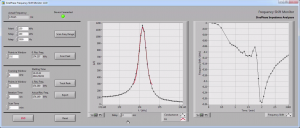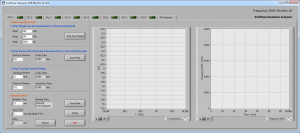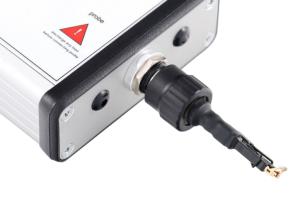Shift of resonant frequency in biological piezoelectric sensors
Shift of resonant frequency in biological piezoelectric sensors

Here, we examine the principles of how biological piezoelectric sensors and impedance analyzers can be used to detect changes in resonant frequency, including some practical applications and key aspects of using the technique.
Impedance analyzers have been used on a commercial basis and increasingly for biological applications since the 1980s. The techniques are relatively easy to learn and use, while equipment has also become increasingly portable and cost-effective due to technological advances over recent decades.
Impedance analyzers are used to measure static resistance and dynamic (or complex) impedance, whether the measurement is between connections of an electrical device under test (DUT) or between two or more points on a material that is under analysis.
In biological applications, electrical impedance depends on the level of opposition to the flow of electrical currents through the body or sample tissue(s) being measured. In humans, impedance may be measured from the wrist to opposite ankle, using up to four electrode sensors and a very low current of between 1-10 microamperes. The results can then be interpreted to gauge various medical criteria such as total body water (TBW) or changes in cellular structure, particularly through cellular surface characteristics.
Biological sensors are different from standard electrical sensors in that the resonant frequency changes are caused by cells reacting with and adhering to a differently coated surface. This adherence will increase the biomass, which will lead to decreased resonance and, therefore, a change in the resonant frequency. This principle is used in quartz crystal microbalance (QCM) systems.

using a SinePhase Impedance Analyzer
A QCM measures changes in density or film thickness (such as those caused by cellular surface deposits) within a certain area. A quartz crystal resonator generates various frequencies and then the changes in the response received from the tissue or sample are recorded. In addition to the resonator, the system also includes a quartz crystal sensor within a temperature-controlled mounting, as well as an electronic controller that monitors the frequency response over time.
Modern techniques allow QCMs to be used with liquids, giving precise results and therefore very effective for determining the affinity of proteins and other molecules to surfaces with defined characteristics. This methodology means that polymers, viruses and other biomolecules including bacteria and pathogens can be detected and investigated.
Apart from measuring the resonant frequency, another characteristic known as the dissipation factor can also be determined as part of the analysis process. Dissipation factor is related to frequency response bandwidth and gives an indication of the viscoelasticity of the sample being examined. Over recent years, improvements in crystal design, transducer engineering and the measurement of very short time intervals have combined to improve the accuracy of this technique.
For analyzing the resonant frequency and any changes over time, an impedance analyzer is necessary. The standard analyzer software measures the conductance and its peak (i.e. resonant frequency) over the frequency range in question, using the software fitting tool and a single measurement sweep.
This standard measurement can be extended so that the resonant frequency value is tracked continuously and displayed over time. This is known as a frequency shift monitor and an example can be seen in the example picture on this page as well as in the video section area. This tracker solution or a similar configuration can be implemented for your project through a separate customized systems project. Of course a multi-channel solution (using eight channels, for instance) is also possible if a parallel frequency shift tracking system is needed, such as the shown example picture.
Customized Systems
At SinePhase, impedance analysis technology is not limited to a standard configuration; our products can be customized and are available with bespoke implementations and options to suit your requirements. Our experienced specialists will work with you to specify, design and manufacture customized hardware solutions that are based on our successful platform.
Extra functionality enables additional analysis with just a few keystrokes and gives quick indications of significant information including Q factor and half-value-bandwidth. Additionally, the extra correlation tool calculates and plots graphs of frequency shifts to illustrate current and earlier measurements and highlight any differences.
With our customized software, your individual analyzer system can be best adapted to your application environment, with performance parameters optimized through:
- parallel or multiplexed multi-channel inputs.
- tailored frequency range(s).
- customized adapters and connections.
- tailored measurement accuracy for specific impedance magnitudes.
- seamless integration of SinePhase hardware and software into multifunctional test configurations and rigs.
If you wish to discuss your requirements or require further information about customized biological measurement solutions, please contact us – we will be pleased to help.
In this section you find following video (just scroll down) regarding monitoring of resonance frequency shift.
- Monitoring frequency shift – SinePhase Impedance Analyzer
1. Monitoring frequency shift - SinePhase Impedance Analyzer
Analyzing shift of resonance frequency of a piezo-based sensor as a function of temperature variation by repeated detection and data logging of resonance frequency over time.
This effect can be used for the precise measurement of a varity of physical properties such as: weight, mass (quartz crystall microbalance – QCM), pressure, temperature, layer thickness, shear force, etc., in combination with biologically active surface coating. The effect can also be used for detection of certain antibodies, virus, bacteria, or chemical components and spurious contaminations in liquids.
Video length: 3 minutes 57 seconds | Resolution: 1080p
Do you have any questions regarding our Impedance Analyzers | LCR Meters?
Please feel free to contact us. You can call us (telephone number on top of website) or just use this simple contact form below.
Get in contact
SinePhase Impedance Analyzer and LCR Meter are designed for measurements up to 16777 kHz.
- Model 16777k for measurements between 1 kHz and 16777 kHz.
- Model 2097k for measurements between 1 kHz and 2097 kHz.
- Model 262k for measurements between 1 kHz and 262 kHz.
In addition, Impedance Analyzer Models 2097k and 262k are offered in two versions covering individual impedance precision ranges.
They can be operated directly from any standard Laptop or PC without the need for additional battery power pack or main supply.
USB Power & Control
The USB power and control concept does not only turn the instrument into the smallest and most mobile of its type, but also features fully integrated PC control and data acquisition as the standard mode of operation.
Products & Services
MEASUREMENT SOFTWARE
Easy-to-use self-explanatory
All instruments are supplied with easy-to-use self-explanatory measurement software.
In addition to the wide range of functions provided with the standard measurement software, SinePhase also offers optional tools like the Fitting Tool or the Correlation Tool. Based on feedback by our customers, SinePhase is commited to continuously extend its library of readily available optional tools.
CUSTOMIZED SYSTEMS
Individual Analyzer Systems
SinePhase impedance analysis technology is not limited to our standard product family. Our experienced specialists will work with you to specify, design and manufacture customized hardware solutions that are based on our basic analyzer hardware platform. Combined with customized software there are no limits to realize individual analyzer systems that fit your particular application environment.
OEM SOLUTIONS
OEM & Embedded Solutions
For industrial customers SinePhase impedance analyzer technology is also available on an OEM basis, by embedding SinePhase core technology into your product design.
Please contact us for further information.


